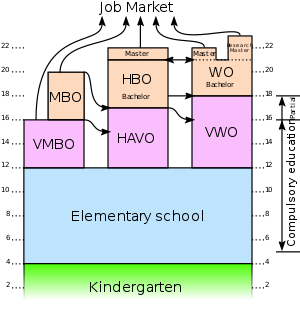 | |
| Ministry of Education, Culture and Science | |
|---|---|
| Minister of Education | Eppo Bruins and Mariëlle Paul |
| National education budget (2014) | |
| Budget | €32.1 billion ($42 billion) |
| General details | |
| Primary languages | Dutch Bilingual/Trilingual (with English, German, French or West Frisian (only in Friesland)) |
| Current system | 1968 (Mammoetwet). 1999 (latest revision). |
Education in the Netherlands is characterized by division: education is oriented toward the needs and background of the pupil. Education is divided over schools for different age groups, some of which are divided in streams for different educational levels. Schools are furthermore divided in public, special (religious), and general-special (neutral) schools,[1] although there are also a few private schools. The Dutch grading scale runs from 1 (very poor) to 10 (outstanding).
The Programme for International Student Assessment (PISA), coordinated by the Organisation for Economic Co-operation and Development (OECD), ranks the education in the Netherlands as the 16th best in the world as of 2018.[2] The Netherlands' educational standing compared to other nations has been declining since 2006, and is now only slightly above average.[3] School inspectors are warning that reading standards among primary school children are lower than 20 years ago, and the Netherlands has now dropped down the international rankings. A similar trend is seen in writing and reading, maths and science.[3] The country has an on-going teacher shortage and lack of new teachers.[3]
The average OECD performance of Dutch 15-year-olds in science and mathematics has declined, with the share of low performers in reading, mathematics and science developing a sharp upward trend.[4] The share of top performers in mathematics and science has also declined.[4][5]
- ^ "Pagina niet gevonden – LOBO". Archived from the original on 2015-06-21. Retrieved 2011-04-18.
- ^ "OECD.org" (PDF).
- ^ a b c "Compare your country to the OECD average". PISA. OECD. Retrieved 11 April 2018.
- ^ a b "Compare your country - PISA 2018".
- ^ "OECD.org" (PDF).